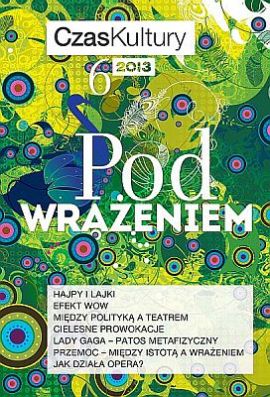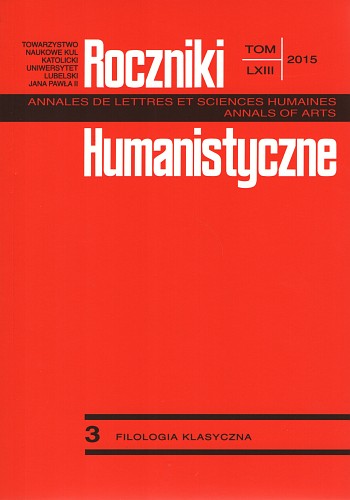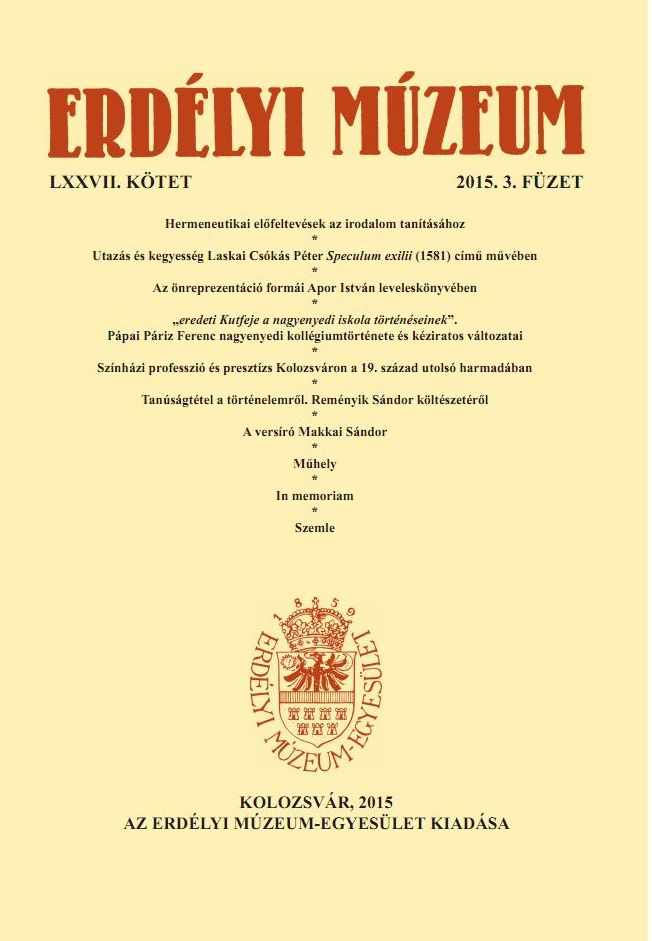
We kindly inform you that, as long as the subject affiliation of our 300.000+ articles is in progress, you might get unsufficient or no results on your third level or second level search. In this case, please broaden your search criteria.



The aim of the paper is the reexamination of the sources concerning the plebeian gens Decia to find a convincing explanation for the fact that one branch of this family was given the surname of “Mus”. At the beginning, two previous explanations of the enigmatic name’s origin are criticized. Firstly, I object to the interpretation of Laurens F. Janssen, who connects the animal surname to a devotio ritual performed by Publius Decius during the battle at Veseris in 340 B.C. Secondly, counter-arguments are presented against Jacques Heurgon’s opinion that there might be an etiological legend in the Livy’s description of the courageous exploits of P. Decius, the tribune of 343 B.C. The next, proper part of the article constitutes an attempt at a wider description of the factors which may have led to the creation of the cognomen “Mus”. To begin with, the remaining Roman aitiological legends, explaining the origin of surnames in certain families, are recalled. Moreover, an attempt is made to determine, at what time Decii were called “mices”. At last, I introduce the significance of the rodent in the Roman culture, which refers to the daily life and among which is usage of the word “mouse” as an invective. I eventually try to argue that Publius Decius (cos. 340 B.C.) received the cognomen due to his political connection with influential plebeians of the fourth century B.C.
More...
Adversus Nationes by Arnobius is a controversial apologia. What may surprise the reader of Adversus Nationes the most is the concept of creating the man which alludes to Plato's Timaeus but also the contempt for all that is human – his body, his condition and his soul. It must be stressed, however, that such attitude was common in the culture of this time, reaching its peak in gnosticism. According to Arnobius, human mind is not capable of comprehending the nature of God and at the same time it does not allow to practice pointless, often bloody cults. This article attempts to show Arnobius's apologetic strategies, which aim at discrediting senseless piety. According the Rhetor of Sicca Veneria, religiousness without reason is nothing more but superstition. In Adversus Nationes Arnobius laid foundation for many centuries long debate on the question of fides et ratio.
More...
In this essay, the author deals primarily with the following topics: poetry as locus theologicus – a place of encounter with God, hymns of Prudentius’ Cathemerinon and their Christocentric dimension. The twelve lyrical poems by Prudentius, collected in Cathemerinon, are hymns for Christians’ every day. They could be used for private meditation and prayer; as a whole, they have a literary character. The hymns were written for an aristocratic audience of the fourth and the first half of the fifth century for those really keen on poetry and the Christian Doctrine. All the hymns discussed in this essay focus the most important aspects of human life on Christ as the source, the light and the ultimate destiny of every human being. The symbolic exposition occurs in most of the hymns. Prudentius very often uses metaphor of light which symbolize Christ and the Christian Doctrine. He also shows a mastery of language and classical metric threads.
More...
The German Jesuit, Jacob Masen, in his poetics treatise entitled Ars nova argutiarum, in addition to the theoretical content, he presents work he prepared himself illustrating the concepts under discussion. Unlike in the earlier part of the work, in Chapter 8 of his dissertation, he presents elaborate poems. He divides them into two cycles. This article is concerned with epigrams on Christmas, which appear in the collection entitled De Christo nato. Out of this group of nine, seven were translated and analysed, and although they were considered by the author as long, their length did not exceed the commonly accepted length for such type of work. As it turned out, the poems prove in many places the author’s erudition. He uses vivid vocabulary, extraordinary words and words originating from mythology and poetic neologisms. At the same time he introduces a wide range of stylistic devices and figures of speech. By the use of descriptio rerum a partium numeratione his topics are presented in an extremely vivid way. The starting point for his descriptions is often the Child Jesus himself depicted from the perspective of an ordinary observer or a conscious of things theologian. Some other time, the scholar starts from the circumstances of the event (circumstantiae) and on their basis the whole performance is built. All the poems are built based on the theory of sources (fontes) and veins (venae) expounded in the dissertation. These pieces of his work are not so much within the rhetorized poetry as within poetry guided by logic. They do not have particularly distinct argutias but this is also in line with the preliminary assumption made by the poet. On the other hand they all form a sort of itinerarium necessary to understand baroque poetry which often, due to its intricacy, appears to be not much interesting and even worthless. It is enough to analyse just a few epigrams by Masen to see that to find the whole range of ideas and solutions concealed by the poet in his poems unconventional literary methods should be used within his poetry.
More...
The results of the present paper are connected to the author’s former study on the earliest Hungarian text records published in 2013: “Chronology and text-reconstruction: on the fundamental matters of the Königsberg Ribands discovered 120 years ago”. (Nyelvtudományi Közlemények 109. 267–336.) By analysing the archaic word-forms occurring in the earliest Hungarian texts the author establishes the following absolute chronological order of these records:Funeral Sermon and Prayer HBK probably 1160–1185; i.e. around 1173. Miracle of the Virgin Mary SzMCs probably 1180–1205; i.e. around 1193. Old Hungarian Lament of the Virgin Mary ÓMS probably 1200–1225; i.e. around 1213. Old Hungarian Annunciation ÓAÜ probably 1275–1300; i.e. around 1288. In the 3rd chapter of the present communication the author discusses a completely new explanation of the expression kyniuhhad occurring in the Old Hungarian Lament of the Virgin Mary. Contrary to former explanations, he concludes that it is a composite form: kyn + iuhhad, meaning ’pain subsides’. This explanation is in full agreement with the written form and fi ts perfectly to the text semantically as well.
More...
There is a large number of pronominal adverbs representing particular clusters – lexemes, formed by means of agglutination of ancientprimary elements – partícules under the influence of the Wackernagel’s law found in dialects of Karelia and adjacent regions.The paper studies structural and semantic characteristics of the adverb zde and its derivatives zdes’a, zdeka, zdekava etc., fixed inthe “Dictionary of the Russian dialects of Karelia and adjacent regions” and the “Dictionary of the Russian national dialects” fromthe point of synchronous and diachronous approaches. The study shows that lexemes formed on the basis of the particule se/sь asan indicator of certainty, consist of two, three, four or five components. An archaic form zde (zd’o, zdi) is a two-component clusterthat functioned in the ancient Russian language and is encapsulated in the dialect speech. Structurally more complex lexemes appearin the dialects through the attachment of formants -s’a (-s’), -ka (-ku, -ko, -tka, -tko), -ne, -va etc. The third, the fourth and the fifthcomponents are desemantised; the formant -s’a (-s’), apparently, is an exception. The attaching particules bare a stressing and highlightingfunction. The three-component clusters were formed in the Old-Russian period; the four- and the five-component clusterswere formed later. There is a tendency of adding the fifth component -to to the adverbs (zdes’aka-to, zdes’atko-to), but new lexemesare not formed.
More...
The article presents the analysis of models of a person’s name recorded in business correspondence of Karelia of XV–XVI centuries.The author considers reasons of diversity and variation of person’s nomination in texts of regional written monuments; status and roleof additional identifications of a person (names of persons related in kinship, according to professional activities, social status, placeof residence) in structural models, containing different number of members. Conditions of onymization of additional identificationsare defined, the main of which are the social status of the person and internal resources of the onomastic system.
More...
The author describes the lexis of Russian sub-dialects, that originated from the words with initial liquid consonants and modifiedphonemic structure of the root morpheme. The lexis is classified according to the detected processes of anlaut-transformation fromр- and л-: when the liquid consonant is lost (алаки < лалаки, рукотер < укотерат, иловый < лиловый, ебро < ребро); whena prosthetic vowel before a liquid consonant is manifested (орайский < райский, улупы < лупы); when there is metathesis of initialsounds (урбáнок < рубáнок, ерестр < реестр); exchange of liquid tones (рипок < липок, лянда < рянда). The features given aboveare found out in the group of words with secondary, “intermediate” р-/л-anlaut (арабéльки < грабельки, улько́за < глюко́за). Theauthor also gives an areal description of modified lexis. The changes are caused by the impact of agglutinating languages on theRussian lexis during the long co-existence of ethnics on the Russian territory.
More...
The article is built on the understanding of the phenomenon of “eternal images” relevance which have become the mythologemesin the world culture. The analysis was drawn on the Scandinavian information – the oeuvre of Norwegian playwright Henrik Ibsen.The author of the article uses a comparative approach, methods of motive analysis and ontologicalpoetics to reveal the particularitiesof presentation of Henrik Ibsen’s riddle play “Peer Gynt” on the stage of Moscow State Theatre “Lenkom”. The article hasinterdisciplinary nature. The analyzed interpretation has some points coinciding with the canonical text, as well as some directorialtransformations.
More...
The article is focused on the first translation of Boris Pasternak’s novel “Doctor Zhivago” into the Swedish language. The book waspublished in 1958 and governed the Swedish reader’s attitude to the Russian author’s oeuvre for a long period. The article presentssome reflections on historical, cultural and linguistic study of the novel’s translation. The composition of the translated text has someadditional elements: a list of characters, a short glossary of difficult words and the story line description. The analysis of the contentrelatedlevel reveals some linguistic and cultural aspects of the Swedish translation, which are connected with the translators strivingfor rendition of the original’s national and cultural components (use of terms of address) and unique imagery (use of various methodsof idiom translation). In 2017 a new translation of Boris Pasternak’s novel “Doctor Zhivago” into Swedish is going to be published.That can contribute to the original’s actualization and being in demand in a new historical and cultural period. A comparative analysisof two translations can reveal new trends in perception of Russian literature by Swedish audience.
More...
The article considers the issues of biblical texts reception in the poetry of D. S. Merezhkovsky of 1880–1890’s. It analyzes the worksincluded in the first two collections of poems: “Poems (1883–1887)” and “Symbols”. Attentive study of the poems leads to the conclusionthat Merezhkovsky’s poetry at this stage reflects the evolution of his interests and outlook: from enthusiasm towards civilsubjects to the turn towards Christianity. The accents in biblical texts interpretation change in accordance with this trend. Orientationon Old Testament imagery and prophetic style predominate in the first book of poems. The article considers the silence motif, whichis adopted from Book of prophet Isaiah. Different interpretations of this motif can be revealed: from the sign of God’s presence to thesign of imminent end of the world. The theme of divine retribution, images of the Old Testament prophets are related to the themeof the “lost generation” of the XIX–XX centuries turn. The second collection of poems contains evangelical reminiscences andelements of parable, a prayer and hagiographic forms. The poet’s appeal to the genre of Christian legend is examined in the article.Merezhkovsky’s legends reflect philosophical comprehension of Gospel commandments in correlation with the realities of modernlife. Different genres and themes represent not only literary treatment of Old Testament, Christian motifs and images, but author’sinterpretation and original arrangement of traditional themes.
More...
The article is devoted to topical issues of modern translation studies, focusing its attention on reviewing linguo-cultural and linguoregionalaspects of the translation. Research is devoted to the problem of transmitting non-equivalent vocabulary of Russian andModern Greek languages. Specificity of the concept of “non-equivalent vocabulary” is revealed. Classification of individual conceptsand realities is presented with examples from the Russian and Modern Greek languages. The main methods of the study weretransformational and comparative ones. The author describes the major modes of “untranslatable” lexical units transmission in thestudied language pair. Translation operations which are used in the transmission of vocabulary without translation equivalents areconsidered: individual concepts (transcription methods, transliteration); realities (phonetic methods, descriptive translation, semanticneologism, approximate translation, mixed techniques, transformational translation). The author comes to the conclusion that none ofthe options used as the transmission sources for non-equivalent elements may serve as a full replacement of the original text.
More...
The article presents author’s observations of the creative history of N. S. Leskov’s novel “The Evildoer of Askalon”. It has beenestablished that the starting point for writing the story was not Prologue (1642–1643), but an outline in the writer’s notebook madeby an unidentified person. In the process of fixing the unknown person kept its concept and plot. Leskov refreshed the fixed story in1886–1887. On this basis the writer created the 1st edition and included it in the series of The Legendary characters. Following theconcept and plot of the borrowed story Leskov edited it. In the center of author’s attention were the images of “some woman” (herappearance became more vital, it emphasized compassion, humility, chastity) and of “a robber” (the author added the situation ofhis inner transformation using archaisms instead of modern vocabulary). Leskov changed the images order to humanize the Gospel.The writer returned to the edited source in 1888 and produced the 2nd edition titled “The Evildoer of Askalon”. Leskov rewrote the1st edition into a moral and philosophical novel. The story was to answer the question “what is a good life?”. Such interpretation ofthe original text caused a further adjustment of images of “some woman”, “merchant”, “great men”, “robber” (endowing the characterswith names and biographies). The story was published in 1889 (“Russian idea” № 11 – the 1st version of the 2nd edition). Thewriter made only minor changes that did not violate the general ideological concept of the work. In 1890 Leskov included the novel(the 2nd version of the 2nd edition) in the Collected edition (SPb., 1890. Vol. 10) with minor stylistic corrections.
More...
The issue of ancient traditions significance in the works by I. Turgenev is researched insufficiently in contemporary literary criticism.Due to his excellent education Turgenev was familiar with the ancient classical tradition and had great command of ancientlanguages. This affected his work and philosophy. Extensive correspondence of Turgenev gives great opportunities to explore thecreative method of the writer, as he often mentioned important issues of philosophy and art in his letters. The Russian writer oftenquoted ancient authors and these quotes often contained important philosophical and aesthetic postulates. The article reviews oneexample of Turgenev’s ambiguous attitude to Virgil’s poetry. While he treated Virgil’s poetry critically in his early writings, a matureand accomplished writer Turgenev turned to Virgil’s poetry among other things as the example of high poetic art that always retainedits relevance from the point of view of art form perfection and depth of psychologism. The quotes from the letter to A. Fet of September13, 1873 are of the most interest for the study. Turgenev cited several phrases of “the Aeneid”, demonstrating that Virgil “isnot only a poet but also a daring innovator and romantic” and showing his poetic sensitivity and deep psychologism in creation ofimages there. Despite the fact that the relationship between writers after this letter went wrong soon, Fet, apparently, did not forgetTurgenev’s opinion about the poetic language of Virgil and used it in his own translation of the “Aeneid”, which he made after thedeath of his friend-enemy. Analysis of the two quotes from Virgil shows not only Turgenev’s good knowledge of the Latin text, butreveals the depth of his understanding of ancient classical tradition importance for modern literature.
More...
It has been recently discovered that the novel of a famous Soviet writer I. A. Efremov “Tais Athenian” existed in two editions (apartfrom a shortened version published in magazine “The Young Guard” in 1972). These two editions were included into the Collectedworks of 1986-89 and 1992. The edition of 1992 is called a “full author’s” one while the absolute majority of the novel published asa separate book are guided by the edition of 1989. The article compares these two editions, identifies and systematizes the revealeddiscrepancies. The bigger part of corrections is connected with censor’s cuts associated with sex-relations issues (as far as it was possibleto do in the novel where the main character is the hetera). In the article we present the most interesting groups of discrepanciesand a short analysis of examples of editorial changing.
More...
This article explores the American television series Zoo (CBS, 2015–2017). The show’s convoluted narrative revolves around mutations that are put into motion by genetic engineering. These mutations first affect animals and later humans The article argues that the biotechnological control of life, which takes center stage narratively, is mirrored in the television show’s use of digital visual effects to create animals. More importantly, Zoo suggests that this control of life is nothing but an illusion, as the mutation quickly gets out of hand and leads to unexpected consequences. Thus, the television series reflects the Anthropocene condition, which is characterized by the emergence of humankind as a planetary force; however, the planetary effects of anthropogenic activities have been largely unwanted. While Zoo seems to expose these processes of our age, the article also stresses that as a television show, Zoo must reach a broad audience. Thus, the critique of human fantasies of planetary control are, somewhat paradoxically, accompanied by an anthropocentrism which arguably undermines the show’s ecological subtexts.
More...
Podcasting is an increasingly popular audio-only, on-demand narrative form that draws millions of listeners, both within the U.S. and worldwide. While podcast scholars are excited about podcasts’ potential to create content that finds no place in the mainstream media, they have not yet investigated how contemporary fictional podcasts can create societal critiques. This paper investigates the political potential of critical news platform The Intercept’s special feature audio play Evening at the Talk House (2018) by analyzing its content, form, and funding model. I will argue that Evening at the Talk House effectively uses the affordances of both the podcast and the dystopian narrative mode to expose the U.S. empire for American citizens by collapsing the distinction between the ‘good’ and safe homeland and the evil ‘other’ abroad. Evening at the Talk House, thus, raises questions about the complicity of regular citizens in enabling ‘murder programs’ (e.g. drone strikes, wars in Iraq and Afghanistan) as citizens actively take part in and become the victims of imperial violence. However, consistent with The Intercept’s daily reporting, Talk House fails to address a major motivation of the U.S. empire: establishing and maintaining global capitalism. This neglect can be explained by considering how the platform was established, as tech billionaire Pierre Omidyar provided its funding.
More...
This paper looks at British home décor to analyse its distinct features from the perspective of a specific national identity. It also examines the impact of the upper class’ taste dictating the norms for the rest of society despite having a different cultural capital. The BBC programme, The Great Interior Design Challenge, is examined as a good example of the British tendency to seek advice from authorities in a field who are the arbiters of taste. The specific competitive scheme and aim of this TV programme present a telling body of information to examine which features are favoured among the winners and which are condemned in failed projects. As a result, the programme captures and reflects the preferred national British taste. The concepts and prescriptions of cultural capital as well as media and authorities as the source of taste are visible in this society. The members of the lower social classes, being instructed by the professionals, strive to follow the upper-class’ taste. However, their choices are determined by the education they received and people by whom they are surrounded. The upper classes are more accustomed to art due to their families’ art collections and art education, so their taste is more sophisticated and informed. Moreover, the study of the programme pays attention to the presence of certain distinctive national features of British society visible in its home décor.
More...